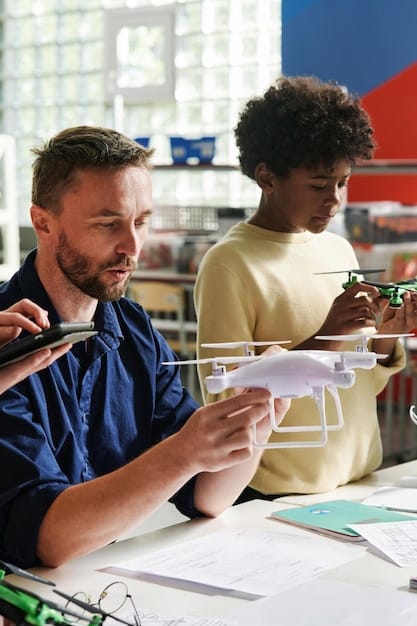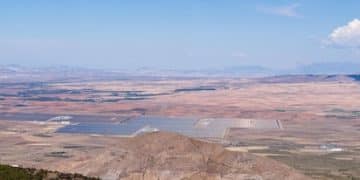Mexico’s Education Reforms: Long-Term US-Mexico Implications

Mexico’s comprehensive education reforms aim to elevate its human capital potential, a development poised to reshape bilateral dynamics with the United States from economic cooperation to migration patterns and cultural exchange.
Understanding the long-term implications of Mexico’s Education Reforms: What Are the Long-Term Implications for US-Mexico Relations? demands a close look at the evolving landscape of one of the world’s most dynamic bilateral partnerships. As Mexico embarks on ambitious overhauls of its educational system, the ripple effects are expected to extend far beyond its borders, particularly influencing its complex relationship with the United States.
Understanding Mexico’s Educational Landscape and Reform Initiatives
Mexico’s educational system, historically marked by disparities and varying quality, has long been a subject of internal debate and reform efforts. The current wave of reforms aims to address these deep-seated issues, seeking to create a more equitable, inclusive, and effective learning environment for all Mexican citizens. These initiatives are not merely tweaks to an existing framework; they represent a fundamental rethinking of how education is delivered, funded, and structured across the nation.
The impetus behind these reforms is multi-faceted. Economic pressures, social demands for better opportunities, and a recognition of the globalized nature of modern economies have all played a role. Mexico understands that a well-educated populace is the cornerstone of sustainable economic growth and social stability. By investing in human capital, the nation seeks to enhance its competitiveness on the global stage, attract foreign investment, and reduce brain drain. The reforms typically focus on several key areas, including curriculum development, teacher training, infrastructure improvements, and increased access to technology in classrooms.
Curriculum Evolution and Skill Development
A significant component of Mexico’s education reforms involves a profound overhaul of its national curriculum. The traditional emphasis on rote memorization is gradually giving way to a more holistic approach that prioritizes critical thinking, problem-solving, and practical skills. This shift is designed to better prepare students for the demands of the 21st-century workforce, equipping them with competencies that are highly valued in a global economy.
* **Focus on STEM fields:** Increased emphasis on science, technology, engineering, and mathematics education from early grades.
* **Bilingual education expansion:** Efforts to promote English proficiency as a crucial skill for future economic opportunities.
* **Vocational training integration:** Greater links between educational institutions and industry to ensure graduates possess job-ready skills.
This renewed focus on practical and globally relevant skills directly impacts the caliber of the Mexican workforce. As more graduates emerge with strong foundations in STEM and English proficiency, their potential for contributing to the binational economy increases significantly.
Teacher Professionalization and Accountability
Teachers are at the heart of any successful educational system, and Mexico’s reforms acknowledge this by placing a strong emphasis on teacher professionalization and accountability. This includes rigorous training programs, ongoing professional development, and performance-based evaluations. The goal is to ensure that educators are not only knowledgeable in their subjects but also equipped with modern pedagogical techniques that foster student engagement and critical thinking.
The modernization of teaching practices is expected to translate into improved student outcomes. A higher quality teaching force can more effectively implement the new curriculum, tailor instruction to diverse learning needs, and inspire a new generation of innovative thinkers. This commitment to educational excellence lays the groundwork for a more skilled and adaptable workforce within Mexico.
The comprehensive nature of these reforms suggests a long-term commitment by the Mexican government to elevate its educational standards. This commitment, if sustained, has the potential to transform Mexico’s societal fabric and its international standing, with specific and profound implications for its closest neighbor, the United States.
Economic Interdependencies and Workforce Impact
The economic ties between the United States and Mexico are profound, characterized by extensive trade, investment, and cross-border supply chains. Mexico’s education reforms, by aiming to cultivate a more skilled and educated workforce, are poised to significantly alter these interdependencies. A higher-quality labor pool in Mexico can lead to a more balanced and symbiotic economic relationship, moving beyond traditional low-wage manufacturing towards more complex, value-added industries.
Shifting Manufacturing and Supply Chains
As Mexican workers become more skilled, particularly in technical and specialized fields, there will be a natural shift in the types of industries that thrive across the border. Companies that might have previously sought cheaper labor elsewhere could find Mexico an increasingly attractive destination due to its proximity to the U.S. market, enhanced infrastructure, and now, a more capable workforce. This could involve expansions in sectors requiring advanced manufacturing, technology development, and even research and development.
* **Increased nearshoring:** More U.S. companies may opt to move production closer to home, leveraging Mexico’s improving human capital.
* **Higher-value production:** Shift from assembly-line work to complex manufacturing operations, including automotive, aerospace, and electronics.
* **Innovation clusters:** Potential for joint U.S.-Mexico innovation hubs, fostering collaborative research and development.
The economic benefits for both nations are clear: reduced logistical costs, increased resilience in supply chains, and the potential for a more integrated North American economic bloc. This evolution would move beyond simple cost advantages to a partnership based on shared capacity and collaborative innovation.

Impact on Bilateral Trade and Investment
A more educated workforce in Mexico directly translates to greater productivity and efficiency, making Mexican goods and services more competitive in global markets. This enhanced competitiveness will undoubtedly boost bilateral trade volumes and encourage further foreign direct investment from the United States into Mexico. U.S. companies will find a more reliable and skilled talent pool, reducing the need for extensive training and improving operational outcomes.
Moreover, as Mexico’s economy becomes more sophisticated, it will also grow as a consumer market for U.S. goods and services. This creates a virtuous cycle where increased Mexican prosperity fuels demand for American products, strengthening economic ties even further. The education reforms act as a catalyst, accelerating this economic integration and fostering a more dynamic trading relationship.
Implications for Migration and Border Dynamics
Historically, economic disparities and limited opportunities in Mexico have been significant drivers of migration towards the United States. Mexico’s education reforms, by improving economic prospects and social mobility within the country, have the potential to fundamentally alter these migration patterns. As educational attainment rises, leading to better jobs and higher incomes, the incentive for irregular migration may decrease, fostering a more stable border environment.
Reduced Push Factors for Migration
A well-educated population, equipped with relevant skills and access to good employment opportunities within Mexico, is less likely to seek economic refuge in another country. The reforms aim to create domestic conditions where Mexican citizens can achieve their aspirations without needing to cross the border. This “pull factor” of internal opportunity can significantly diminish the “push factors” of poverty and lack of prospects that have historically fueled migration flows.
This shift would not only reduce the social and economic pressures on border communities in the U.S. but also allow both countries to focus resources on other areas of cooperation. A more stable and prosperous Mexico, arising from these educational advancements, can serve as a stronger partner in regional development and security initiatives.
Shifting Skill Sets of Migrants
Even with reduced overall migration, the composition of those who do migrate could change. A highly educated Mexican population might lead to an increase in legal, skilled migration to the U.S., filling specific labor demands in sectors like technology, healthcare, or specialized manufacturing. This would represent a shift from the predominantly agricultural and low-skilled labor migration seen in the past, fostering a different kind of cross-border human capital exchange.
Such a change could facilitate more structured and mutually beneficial immigration policies, moving towards systems that attract and integrate highly skilled individuals rather than dealing with the complexities of irregular crossings. This transformation would require careful diplomatic engagement and policy adjustments from both nations to maximize the potential benefits of this evolving human capital flow.
Cultural and Social Exchange Enhancement
Beyond economics and migration, education reforms have profound implications for the cultural and social fabric linking the United States and Mexico. A more educated Mexican populace, often exposed to a broader range of global perspectives and with improved English proficiency, can facilitate deeper cultural exchange, foster mutual understanding, and enhance collaborative initiatives in various social sectors.
Increased English Proficiency and Communication
One of the explicit goals of many educational reforms in Mexico is to increase English language proficiency among its students. This focus is not just economic; it significantly lowers communication barriers between the two nations. Easier communication can lead to:
* **Greater academic exchange:** More Mexican students pursuing higher education in the U.S. and vice versa.
* **Enhanced cultural tourism:** A more confident and informed exchange between tourists and locals.
* **Improved diplomatic dialogue:** Smoother negotiations and understanding in bilateral relations.
The ability to communicate effectively in English opens doors to a vast array of cultural content, from literature and media to academic research, fostering a more nuanced understanding of American society and values among Mexicans, and potentially vice-versa as well.
Academic and Research Collaboration
As Mexico’s educational institutions strengthen their curricula and research capabilities, opportunities for academic and scientific collaboration with U.S. universities and research centers will expand. This could lead to joint research projects addressing shared challenges such as climate change, public health, and sustainable development. Such partnerships not only advance knowledge but also build robust professional networks and foster a sense of shared purpose between the two countries.
These collaborations can also facilitate student and faculty exchange programs, deepening personal connections and fostering a new generation of leaders well-versed in binational cooperation. The synergy created through these academic links can spill over into other sectors, strengthening the overall relationship.
Challenges and Opportunities for Bilateral Cooperation
While Mexico’s education reforms present numerous opportunities for strengthening US-Mexico relations, they also come with inherent challenges that both nations must navigate collaboratively. The success of these reforms, and their subsequent impact on bilateral ties, will depend heavily on the willingness of both governments to engage in strategic partnerships and address potential friction points.
Addressing Implementation Hurdles
Implementing large-scale educational reforms in any country is a monumental task, fraught with challenges. In Mexico, these include:
* **Funding and resources:** Ensuring adequate and sustainable financial support across all levels of education, especially in remote or underserved areas.
* **Teacher resistance:** Overcoming potential opposition from teacher unions or traditionalists wary of new methodologies or accountability measures.
* **Infrastructure development:** Building and upgrading facilities, particularly in line with technological integration.
The United States can play a supportive role by offering expertise in curriculum development, teacher training, and educational technology, perhaps through USAID or academic exchange programs. Collaborative initiatives can help Mexico overcome these internal hurdles more efficiently. Successful implementation of these reforms truly elevates Mexico’s potential as a partner.
Navigating Divergent Priorities and Geopolitics
Despite shared interests, both nations often have unique domestic priorities and differing geopolitical perspectives that could influence cooperation. For instance, economic nationalism in either country could impact trade agreements or investment flows, potentially undermining the benefits of an improved Mexican workforce. It is crucial for both governments to maintain open lines of communication and transparent policy-making to prevent misunderstandings or counterproductive actions.
Diplomacy and ongoing dialogue will be essential to ensure that the positive momentum generated by educational improvements is not derailed by broader political or economic disagreements. Building a foundation of mutual trust and respect is paramount for leveraging these reforms to their fullest potential.
Long-Term Strategic Outlook for US-Mexico Relations
The long-term strategic outlook for US-Mexico relations, influenced by Mexico’s education reforms, points towards a deepening partnership characterized by greater integration in economic, social, and cultural spheres. This evolution suggests a future where both nations leverage their respective strengths more effectively, contributing to regional stability and prosperity.
Enhanced Regional Competitiveness
A more educated and skilled Mexico strengthens the entire North American region in the global arena. As both countries collectively enhance their human capital, they become more attractive for advanced manufacturing, innovation, and technological development, allowing them to compete more effectively against economic blocs in Asia and Europe. This shared improvement in competitiveness could lead to:
* **Complementary economic growth:** Industries in both countries benefitting from cross-border synergies rather than competition.
* **Shared technological advancements:** Collaborative research and development leading to breakthroughs that benefit both societies.
* **Resilient supply chains:** A North American manufacturing base that is robust and adaptable to global disruptions.
This vision moves beyond simply “Made in North America” to “Innovated in North America,” fostering a collaborative environment that capitalizes on intellectual capital as much as physical labor.

Strengthened Diplomatic and Political Ties
Educational advancement often correlates with increased civic engagement and institutional strength. As Mexico’s society becomes more educated, its democratic institutions may also strengthen, leading to a more stable and predictable political environment. This stability is inherently beneficial for the U.S., providing a more reliable partner in regional security, counter-narcotics efforts, and border management.
Furthermore, a more educated populace may lead to increased understanding and empathy between the two nations. Citizens on both sides of the border can better appreciate each other’s challenges and contributions, fostering a diplomatic relationship built on mutual respect and shared objectives, rather than solely on immediate crises or economic transactions.
The trajectory of US-Mexico relations, therefore, is not merely a reaction to external pressures but an evolving partnership significantly shaped by internal Mexican development, particularly in education. The commitment to educational excellence in Mexico is a long-term investment that promises to yield substantial dividends for both nations, solidifying their special relationship for decades to come.
| Key Point | Brief Description |
|---|---|
| 📚 Enhanced Workforce | Reforms aim to create a more skilled, competitive Mexican labor force, impacting nearshoring trends and supply chains for the U.S. |
| 📉 Reduced Migration | Improved opportunities in Mexico may decrease irregular migration to the U.S., fostering more stable border dynamics. |
| 🤝 Deeper Collaboration | Increased English proficiency and academic quality can lead to stronger cultural and research partnerships between the nations. |
| 📈 Regional Competitiveness | A more educated Mexico strengthens North America’s position in global markets, fostering shared economic growth. |
Frequently Asked Questions About Mexico’s Education Reforms
Mexico’s education reforms primarily aim to enhance the quality, equity, and relevance of its educational system. Key objectives include curriculum modernization to foster critical thinking and practical skills, professionalization of teachers through improved training and accountability, and a greater emphasis on subjects like STEM and English proficiency to prepare students for the demands of the 21st-century global economy.
The reforms are expected to significantly improve the Mexican labor force’s skill set and competitiveness. By focusing on higher-value skills, vocational training, and language proficiency, Mexico aims to produce a workforce capable of supporting more sophisticated industries. This could attract more foreign direct investment, shift manufacturing towards complex processes, and reduce the brain drain as more opportunities arise domestically.
Yes, improved education and subsequent economic opportunities in Mexico could potentially reduce irregular migration to the U.S. As access to better jobs and higher incomes within Mexico increases, the economic “push factors” for cross-border migration may diminish. This shift could lead to more stable border dynamics and potentially an increase in legal, skilled migration tailored to U.S. labor demands.
The U.S. could support Mexico’s education reforms through various collaborative efforts. This might include sharing expertise in curriculum development, teacher training methodologies, and educational technology. Academic exchange programs, joint research initiatives, and financial assistance facilitated through organizations like USAID could also help Mexico overcome implementation challenges, fostering a stronger bilateral partnership.
Beyond economics, enhanced education in Mexico promotes stronger cultural and social ties. Increased English proficiency facilitates greater academic and cultural exchange, fostering mutual understanding and diplomatic dialogue. It can lead to more vibrant cross-border tourism and collaborative initiatives in arts, sciences, and humanities, deepening the cultural appreciation and personal connections between the two nations.
Conclusion
Mexico’s ambitious education reforms represent a pivotal moment not just for its domestic development but for the future trajectory of US-Mexico relations. By investing in its human capital, Mexico is poised to become an even more formidable economic and political partner, fostering conditions that could reshape trade, migration, and cultural exchange for decades to come. The long-term implications are overwhelmingly positive, suggesting a deeper, more integrated, and mutually beneficial relationship between these two indispensable neighbors. Continued dialogue, collaboration, and a shared vision for North American prosperity will be crucial in harnessing the full potential of these transformative educational advancements.





